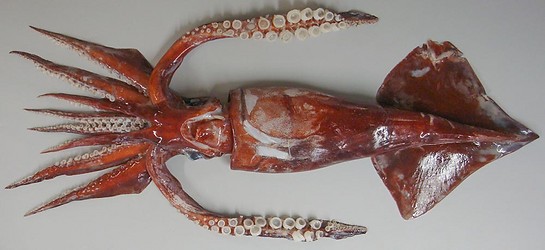Todarodes
Michael Vecchione and Richard E. Young


This tree diagram shows the relationships between several groups of organisms.
The root of the current tree connects the organisms featured in this tree to their containing group and the rest of the Tree of Life. The basal branching point in the tree represents the ancestor of the other groups in the tree. This ancestor diversified over time into several descendent subgroups, which are represented as internal nodes and terminal taxa to the right.

You can click on the root to travel down the Tree of Life all the way to the root of all Life, and you can click on the names of descendent subgroups to travel up the Tree of Life all the way to individual species.
For more information on ToL tree formatting, please see Interpreting the Tree or Classification. To learn more about phylogenetic trees, please visit our Phylogenetic Biology pages.
close boxIntroduction
The five species of Todarodes are partially separated by distribution: T. pacificus, a moderate-sized species (ca. 350 mm ML) and one of the world's most abundant commercial squids, occurs over the shelf and oceanic waters around Japan in the northwest Pacific; the closely related dwarf species (<80 mm ML), T. pusillus occurs in the tropical-subtropical waters of the shelf and upper slope of northern Australia. T. sagittatus, a large species (>500 mm ML) occurs primarily in the northeast Atlantic over the continental slope and into oceanic waters. T. angolensis (>500 mm ML) seems to be the south Atlantic counterpart of T. sagittatus but many details of its distribution are uncertain. T. filippovae (>500 mm ML) has an oceanic circumpolar distribution within the sub-Antarctic and subtropical waters of the Southern Ocean and overlaps the distribution of T. angolensis. (Dunning and Wormuth, 1998; Rodhouse, 1998)Brief diagnosis:
A Todarodinae with ...
- funnel groove with foveola.
- only right arm IV hectocotylized.
- tentacular stalks lacking free trabeculae.
Characteristics
- Arms
- Arm protective membranes and trabeculae normal.
- Right arm IV hectocotylized.
- Arm protective membranes and trabeculae normal.
- Tentacles
- Tentacular stalks without free trabeculae.
- Large, medial club suckers with 20 or fewer long, pointed teeth, with single larger tooth distally in some species.
- Largest manus sucker with teeth linked by intermediate ridges or plates.
- Tentacular stalks without free trabeculae.
- Comparison of species (modified from Dunning and Wormuth, 1998):
T. sagittatus
T. angolensis
T. filippovae
T. pacificus
T. pusillus
No. manus sucker rows
14-18 14-18
12-14
11-12
6-8
No. teeth in largest club sucker
17-20
13-16
7-13
15-20
16-18
Diameter of largest club sucker (% of ML)
2.7-4.0
2.0-2.6
2.7-4.5
---
---
Comments
Characters from Dunning and Wormuth (1998)
Distribution
North and South Atlantic, northeastern Indian, western and southeastern Pacific, and Southern oceans.
References
Dunning, M. C. and J. H. Wormuth. 1998. The ommastrephid squid genus Todarodes: A review of systematics, distribution, and biology (Cephalopoda: Teuthoidea). . Smithsonian Contributions to Zoology, No. 586: 385-391.
Rodhouse, P. D. 1998. Todarodes filippovae in the Southern Ocean: an appraisal for exploitation and management. p. 207-215, In: Large Pelagic Squids, T. Okutani (Ed.) Japan Marine Fishery Resources Research Center, Tokyo, 269 pp.
Title Illustrations

| Scientific Name | Todarodes filippovae |
|---|---|
| Location | NW Chatham Rise (near New Zealand) at 43°11'S, 174°21'E |
| Comments | Bottom trawl at at 590 m depth |
| Acknowledgements | National Institute of Water & Atmospheric Research (NIWA) |
| Identified By | Darren Stevens |
| Sex | Female |
| Life Cycle Stage | Mature |
| View | Ventral |
| Size | 491 mm ML |
| Collection | NIWA |
| Image Use |
 This media file is licensed under the Creative Commons Attribution License - Version 3.0. This media file is licensed under the Creative Commons Attribution License - Version 3.0.
|
| Copyright | © Darren Stevens |
About This Page
Michael Vecchione

National Museum of Natural History, Washington, D. C. , USA
Richard E. Young

University of Hawaii, Honolulu, HI, USA
Correspondence regarding this page should be directed to Michael Vecchione at
vecchioneM@si.edu
and Richard E. Young at
dickphyllisyoung@gmail.com
Page copyright © 2011 Michael Vecchione and Richard E. Young
 Page: Tree of Life
Todarodes .
Authored by
Michael Vecchione and Richard E. Young.
The TEXT of this page is licensed under the
Creative Commons Attribution-NonCommercial License - Version 3.0. Note that images and other media
featured on this page are each governed by their own license, and they may or may not be available
for reuse. Click on an image or a media link to access the media data window, which provides the
relevant licensing information. For the general terms and conditions of ToL material reuse and
redistribution, please see the Tree of Life Copyright
Policies.
Page: Tree of Life
Todarodes .
Authored by
Michael Vecchione and Richard E. Young.
The TEXT of this page is licensed under the
Creative Commons Attribution-NonCommercial License - Version 3.0. Note that images and other media
featured on this page are each governed by their own license, and they may or may not be available
for reuse. Click on an image or a media link to access the media data window, which provides the
relevant licensing information. For the general terms and conditions of ToL material reuse and
redistribution, please see the Tree of Life Copyright
Policies.
- First online 08 March 2011
- Content changed 30 November 2011
Citing this page:
Vecchione, Michael and Richard E. Young. 2011. Todarodes . Version 30 November 2011 (under construction). http://tolweb.org/Todarodes/19939/2011.11.30 in The Tree of Life Web Project, http://tolweb.org/







 Go to quick links
Go to quick search
Go to navigation for this section of the ToL site
Go to detailed links for the ToL site
Go to quick links
Go to quick search
Go to navigation for this section of the ToL site
Go to detailed links for the ToL site